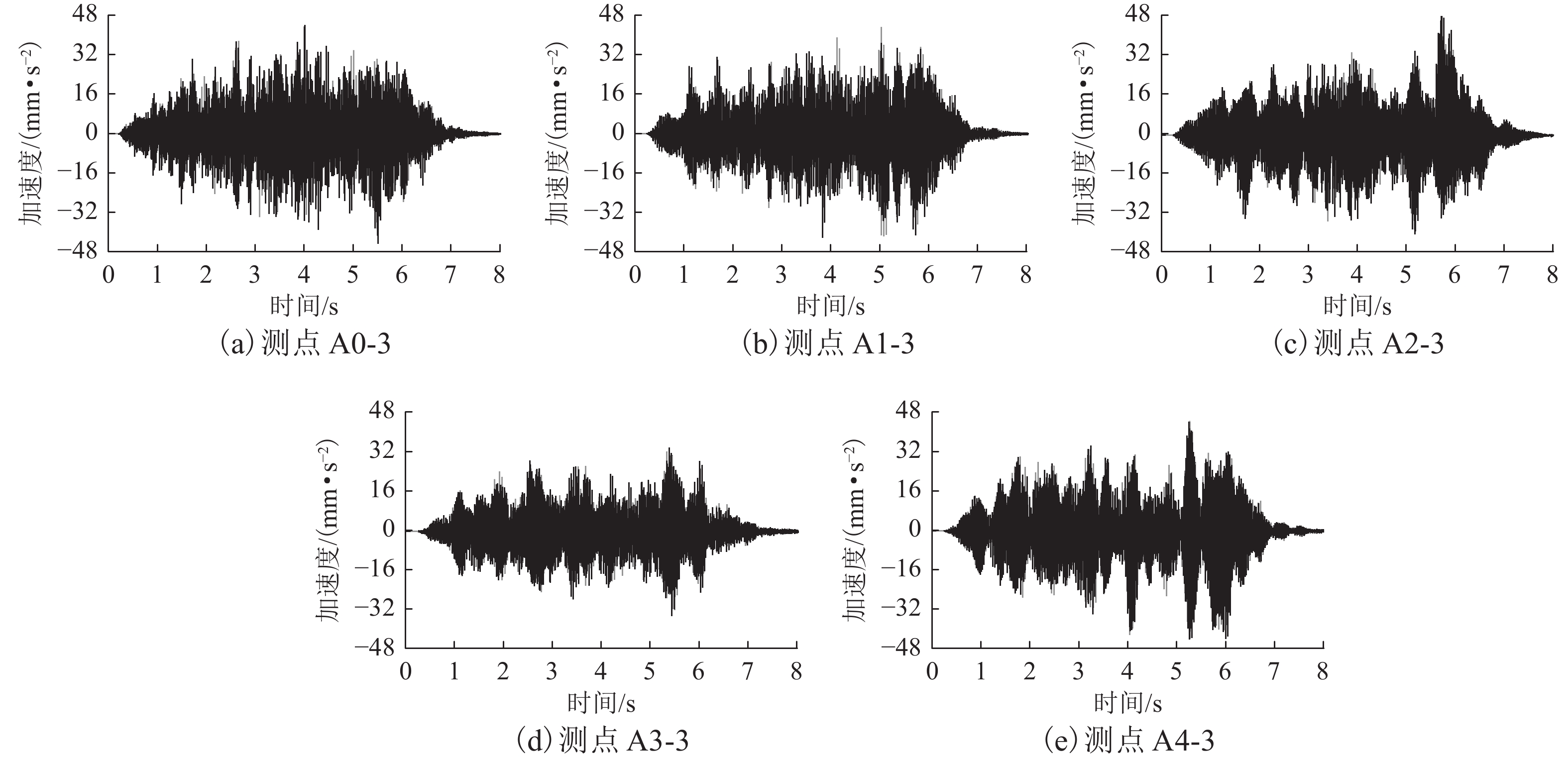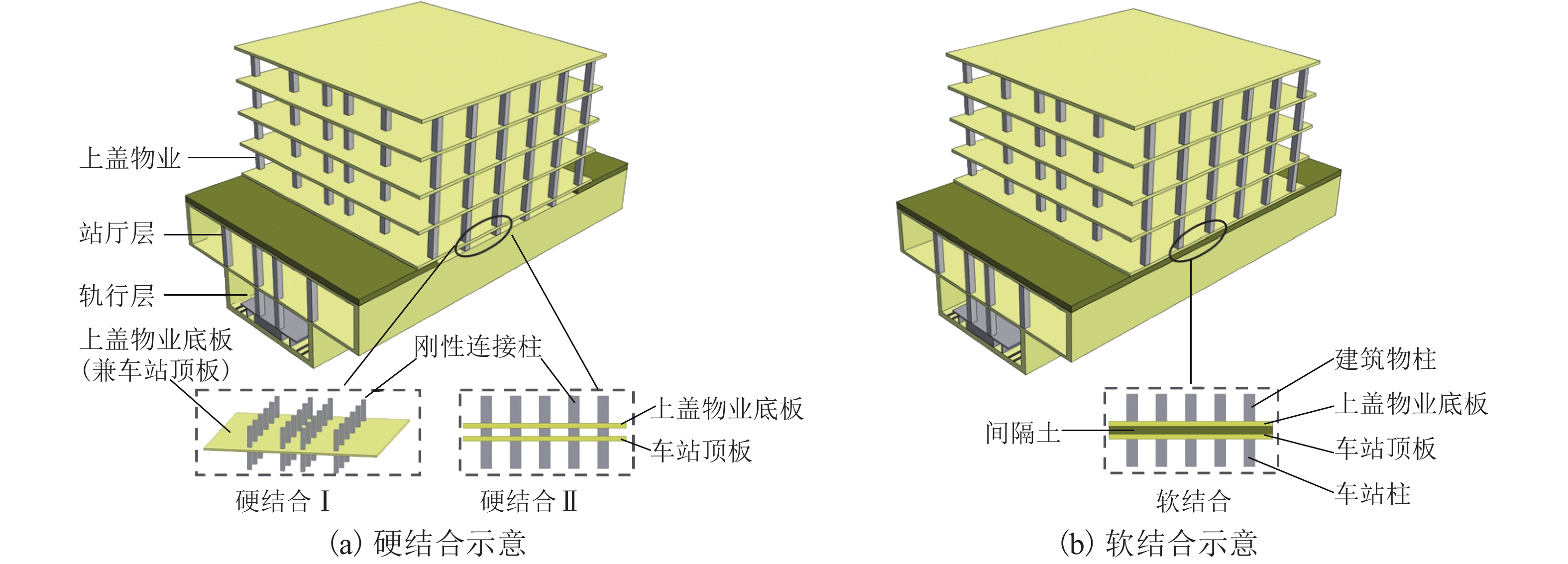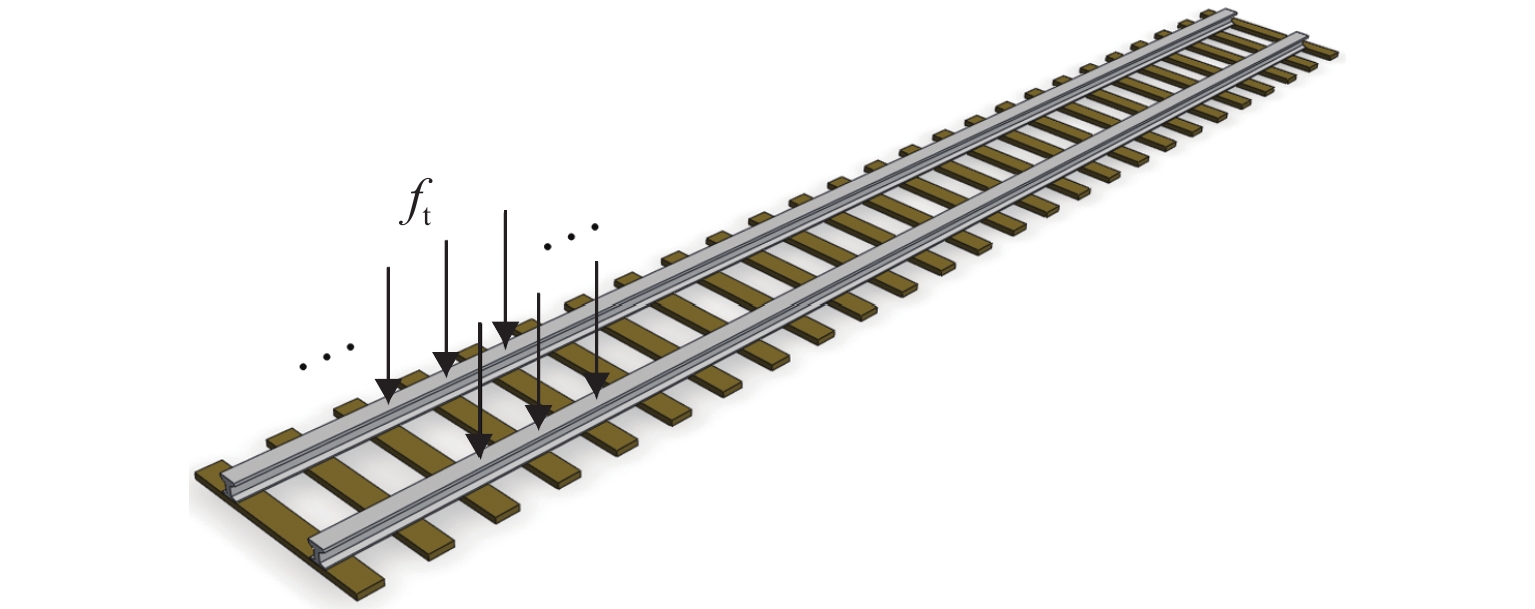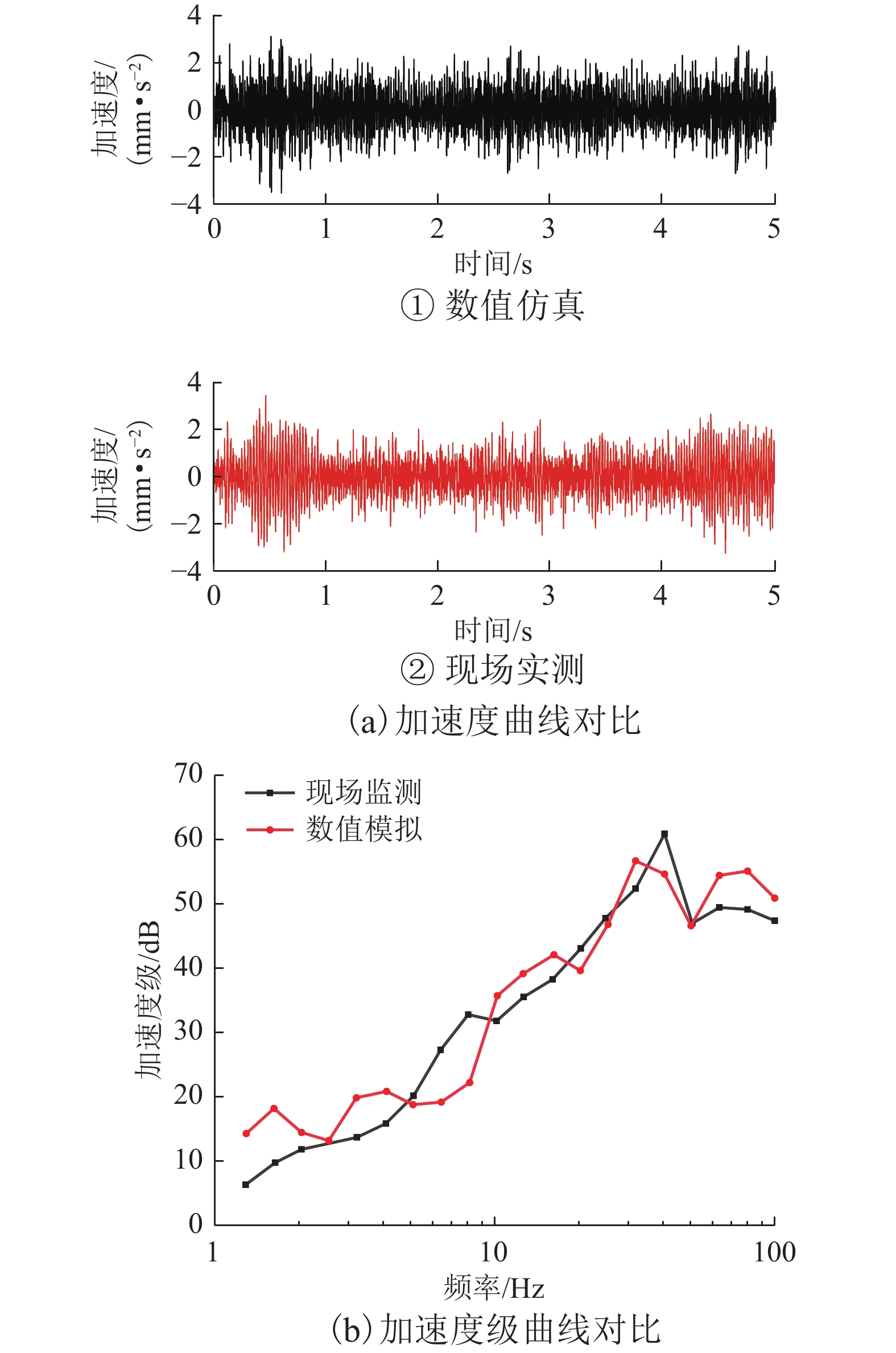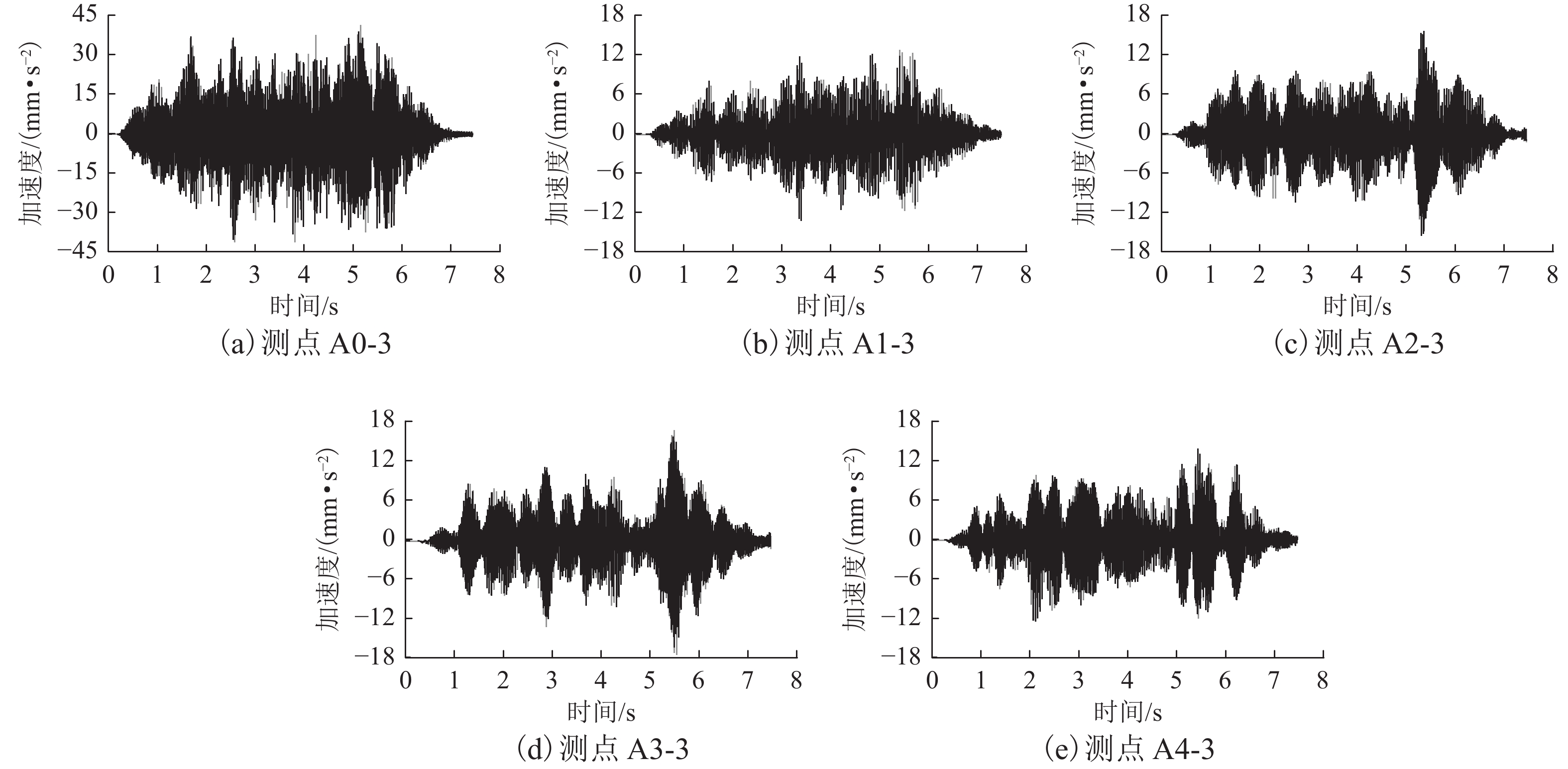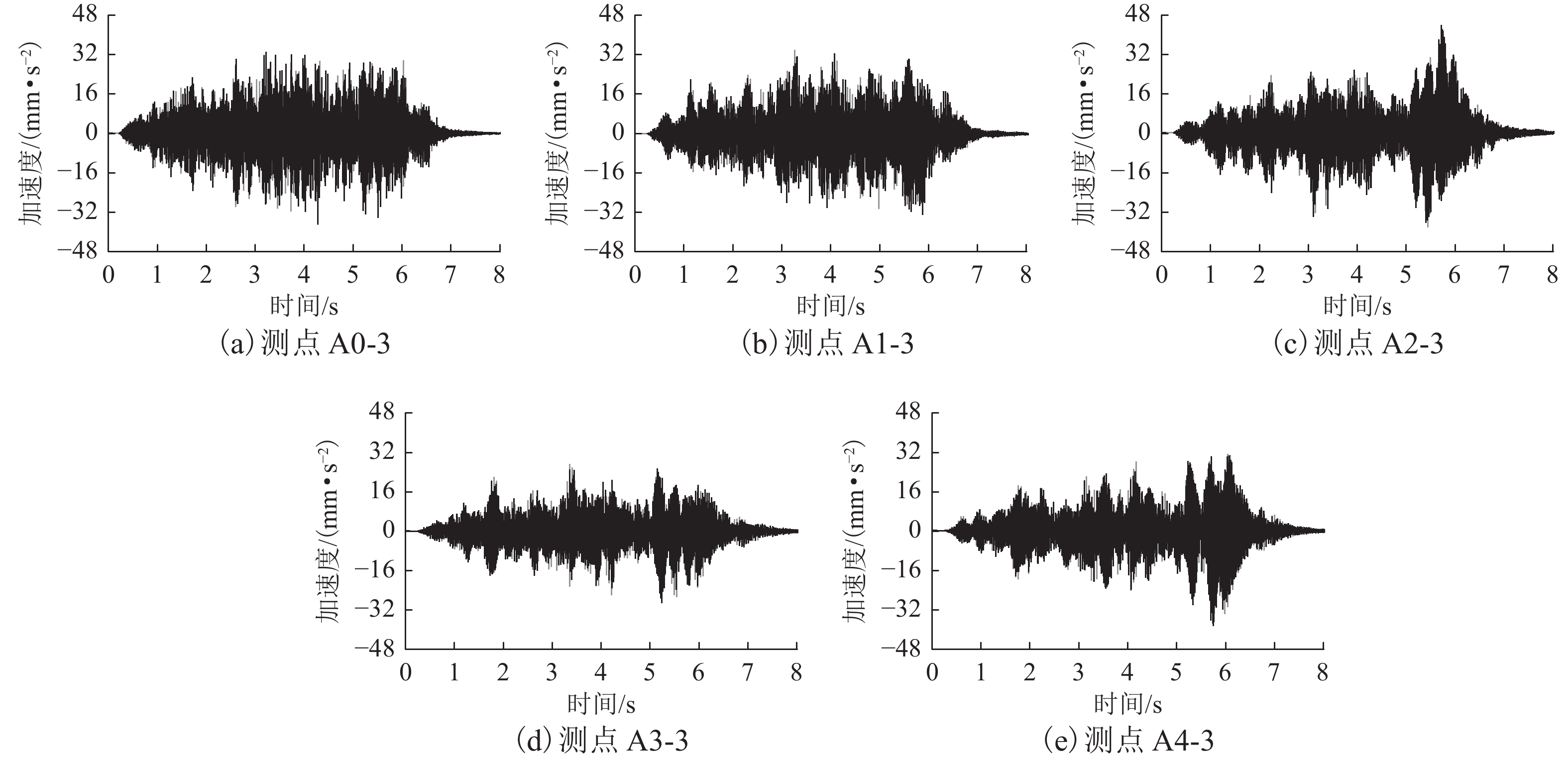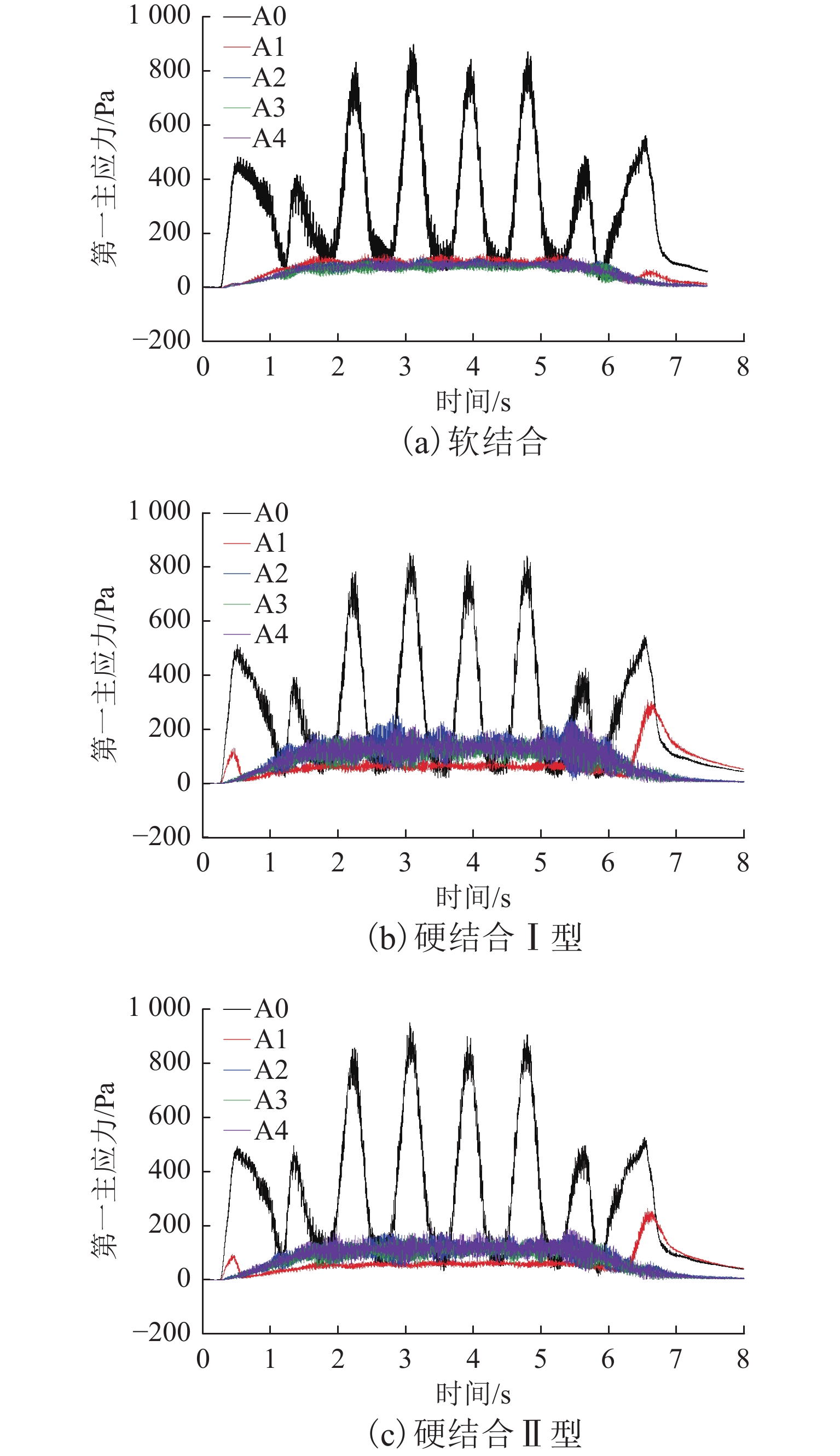Influence of Combination Types on Vibration Response of Superstructure of Subway Station
-
摘要:
为研究地铁振动对不同结合类型地铁车站及其上方的动力反应影响,基于地铁车站与上盖物业连接型式的主要承载区别,提出“软结合”“硬结合Ⅰ”“硬结合Ⅱ”3种结合型式;然后,采用车-轨耦合模型得到列车荷载谱,利用有限差分软件FLAC3D建立地铁车站-上盖物业数值仿真模型,并与实测数据进行对比,验证数值仿真模型与参数的正确性;最后,基于数值仿真,从时域、频域出发,研究3种结合型式下上盖物业的振动响应. 研究结果表明:软结合型式下站厅层到上盖物业一层加速度峰值减小69.10%,硬结合Ⅰ型减小2.08%,硬结合Ⅱ型增大2.94%,硬结合型式下上盖物业振动加速度较软结合型式大;3种结合型式下上盖物业振动的频率主要在40~90 Hz,且对于上盖物业同一楼层,振动随距振源距离的增大而逐渐减小;软结合型式下上盖物业一层加速度级最大值为68.2 dB,较站厅层减小11.3 dB;硬结合Ⅰ型、硬结合Ⅱ型的上盖物业加速度级最大值分别为83.4 、79.4 dB;地铁振动造成上盖物业附加第一主应力很小,且在向上传播过程中衰减很快;从站厅层到上盖物业,软结合型式第一主应力衰减85.81%,硬结合Ⅰ、Ⅱ型式分别衰减63.46%、72.27%,间隔土对附加应力有明显衰减作用. 在地铁实际建设工程中建议选用软结合型式.
Abstract:In order to study the effect of subway vibration on the dynamic response of different types of subway stations and their superstructures, three kinds of combination types, namely “soft combination”, “hard combination Ⅰ”, and “hard combination Ⅱ” were proposed based on the differences in the main bearing of the connection between the subway station and the superstructure. The train load spectrum was obtained by means of the vehicle-rail coupling model, and a numerical simulation model of the subway station-superstructure was established using finite difference software FLAC3D and compared with measured data to verify the correctness of the model and the parameters. Finally, the vibration response of the superstructure under the three kinds of combination types was studied based on numerical simulation from the time domain and frequency domain. The results show that the acceleration peak from the station hall to the first floor of the superstructure decreases by 69.10% under the soft combination and 2.08% under the hard combination Ⅰ, but it increases by 2.94% under the hard combination Ⅱ. The vibration acceleration of the superstructure in the hard combinations is larger than that in the soft combination. The vibration frequency of the superstructure under the three kinds of combination types is mainly 40–90 Hz. In addition, for the same floor of the superstructures, the vibration decreases with the increase in the distance from the vibration source. The maximum acceleration level of the first floor of the superstructure under the soft combination is 68.2 dB, which has decreased by 11.3 dB compared with that of the station hall layers. The maximum acceleration level of the superstructure under the hard combination Ⅰ and hard combination Ⅱ is 83.4 dB and 79.4 dB. The first principal stress attached to the superstructure is very small due to subway vibration, and it attenuates quickly in the upward propagation process. From the station hall to the superstructure, the attenuation of the first principal stress of the soft combination is 85.81%, and that of the hard combination Ⅰ and hard combination Ⅱ is 63.46% and 72.27%, respectively. Furthermore, the spacer soil attenuates the additional stress obviously. It is suggested to choose the soft combination in the actual construction project of subways.
-
Key words:
- subway station /
- superstructure /
- train load /
- soft combination /
- hard combination /
- vibration response
-
地铁具有交通量大、速度快、污染程度小、占地面积小等优点,能在很大程度上缓解城市地面交通压力,刺激城市经济,带动城市经济发展. 但由于施工成本高、工期长、资金回收率高,地铁大都会处于亏损状态,不得不寻求发展新模式. “地铁 + 上盖物业”可以有效利用和节约土地资源,带动相关产业的联合发展,从而提高地铁建设和运营的科学性和经济性.
地铁振动通过道床、隧道结构和基础传递到上层建筑,进而影响上层建筑和人类活动[1-2]. 国内外科学家对此做了大量研究. 邹超[3]以地铁车辆段及其上部建筑为研究对象,分析地铁车辆段及其上部建筑的振动传播规律,建立建筑振动预测模型,提出了有效的振动控制措施. 袁葵[4]分析试车线上盖建筑的车致振动机理、振动传播规律,在此基础上,提出减振降噪措施. 吕文婷[5]利用有限元软件建立车辆段上盖物业模型,并对其振动情况进行预测. 谢伟平等[6]结合2个实际工程,研究地铁列车进出车辆段对上部建筑特性振动的影响,并分析车辆段的振动荷载特性. Qu等[7]研究了地铁列车和公路车辆同时通过时的地面各测点振动响应. Real等[8]建立三维有限元模型,并用现场数据进行验证,预测铁路列车的振动. 赵彦辉[9]基于现场振动测试,探讨空沟和填充沟隔振措施的隔振效果. Yang等[10]通过相似模型试验,研究不同隧道断面对隧道及周围土体动力响应的影响. Zhang等[11]在模型试验中施加了扫频载荷,研究积分横向通道(ITP)的影响机理,提出一种新型的组装横向通道(ATP),并研究其减振效果. 郭治岳等[12]建立一个精细的数值分析模型,研究地铁附近建筑物的振动发展特征. 兰凯等[13]采用两步分析方法,预测列车以不同速度通过时引起的上盖建筑振动,并判断其是否满足标准要求. 孟坤等[14]认为在列车通行过程中,公路桥梁结构构件均存在明显的振动,但未发生扩散性共振效应,振动幅值很小.
国内外科学家也对地铁荷载进行了大量研究:陈行[15]使用国际公认的时间拟合公式确定高速列车的振动载荷;马龙祥等[16]基于无限-周期结构理论,建立车轨动力耦合模型,分析振动源车轨系统的竖向振动,计算列车在频率范围内通过钢轨传递到隧道基底的竖向振动激振力. 基于轮轨关系理论,刘凯[17]建立车辆-轨道系统的动力学分析模型,模拟拉伸载荷;刘维宁等[18]构建高精度的车轨耦合解析模型,并将计算结果与实测数据进行了对比.
综上所述,以往的研究主要集中在地铁振动对车辆段[19]或相邻建筑物的影响[20],而对不同结合类型地铁车站及其上方的动力反应特性的研究很少. 本文基于轨道车辆垂向耦合动力学理论,确定地铁B列列车的振动荷载,建立三维精细数值模拟模型,从时域、频域以及动应力角度,研究不同结合型式下地铁上盖物业的动力响应规律. 研究结果旨在为地铁车站上盖物业的结构设计和动力分析提供参考.
1. 地铁车站上盖物业结合型式
地铁车站与上盖物业的结合型式主要有层间夹土和板、柱等结构直接相连2种型式,在此将其分别归为“软结合”“硬结合”. 其中,“软结合”是上盖物业与地铁车站结构不直接相连,二者之间存在回填或原状夹层,两结构间无刚性连接. “硬结合”是上盖物业与地铁车站间采用刚性连接,具体又分为:1) 硬结合Ⅰ,物业首层作为地铁车站顶板(板共用);2) 硬结合Ⅱ,柱网结合型式(板不共用). 2种结合型式如图1所示.
2. 动力响应分析方法
2.1 列车荷载的确定
列车-轨道振动系统动力学模型分析法是利用解析法或者有限元数值法求解列车荷载,以轮轨不平顺视为车辆振动的激励源,并通过轮轨间赫兹接触关系将其传递到轨道结构中,从而形成整个车轨系统的动力学耦合过程. 车辆-轨道垂向耦合振动的动力模型[21]包括车辆模型、轨道模型和轮轨模型[22]. 车辆模型包括车体、2个转向架以及2组轮对,共计10个自由度.
2.2 数值仿真模型及参数
依托工程为佛山金融高新地铁站,该站为地下2层双柱双跨岛式站台,上盖物业上方有商场及裙楼,车站于下方斜穿上盖建筑,轨道为无砟形式. 采用FLAC3D建立数值仿真模型,鉴于动力计算的难度和耗时,仅考虑受列车振动影响大的上部物业结构. 为减小模型边界效应,确定模型长121.4 m、宽64 m、高72.5 m,地铁车站位于整体模型纵向中心位置. 为精确模拟波的传播,模型网格尺寸应小于输入波形最高频率对应波长的1/8~1/10[23]. 在轨行区、站厅层(A0)及上盖物业(A1~A4)楼板设置25个测点,模型、测点位置及编号见图2.
周边岩土体采用理想弹塑性模型并服从Mohr-Coulomb屈服准则[24],车站结构与上盖物业[25]均为线弹性模型[26]. 动力分析中选用静态边界条件,可有效减小模型边界上的入射波影响[27]. 具体做法是在模型的法向与切向分别设置阻尼器,从而实现吸收入射波的目的.
阻尼器所提供的法向黏性力tn和切向黏性力ts分别为
{tn=−ρCpvn,ts=−ρCsvs, (1) 式中:vn、vs分别为模型边界上法向和切向速度分量,m/s;ρ为介质密度,kg/m3;Cp、Cs分别为P波和S波的波速,m/s.
根据地铁站周边地层勘察资料,车站采用C30混凝土,上盖物业采用C25混凝土,地层、轨道和相关结构的物理力学参数取值如表1和表2所示.
表 1 地层及结构物理力学参数Table 1. Physical and mechanical parameters of strata and structures序号 名称 重度/(KN·m−3) 弹性模量/MPa 泊松比 厚度/m 内摩擦角/(°) 黏聚力/kPa 1 素填土 16.5 18.00 0.33 3.5 5.7 9.4 2 淤泥质粉细砂 17.1 30.00 0.25 6.0 23.0 3 粉质黏土 19.8 105.00 0.32 2.5 22.6 22.2 4 全风化粉砂岩 19.3 225.00 0.29 38 49.3 10.3 5 钢轨 78.5 2.01×105 0.30 6 地铁车站 24.0 3.00×104 0.20 7 上盖物业 24.0 2.80×104 0.20 表 2 轨道部件物理力学参数Table 2. Physical and mechanical parameters of track components钢轨 扣件 道床板 质量/
(kg·m−1)密度/
(kg·m−3)弹性
模量/GPa泊松比 垂向刚度/
(MN·m−1)扣件间距/m 弹性模量/
GPa泊松比 密度/
(kg·m−3)60 7850 205.9 0.30 59.2 0.6 32.5 0.24 2400 2.3 阻尼设置
瑞利阻尼C能够较好减弱系统自振模式的振幅,其矩阵计算如式(2)所示.
C=αM+βK, (2) 式中:α、β分别为与质量、刚度成比例的阻尼常数,M、K分别为质量、刚度矩阵.
阻尼常数可通过最小临界阻尼比和最小中心频率确定. 岩土材料临界阻尼比一般是2%~5%[24],而结构系统的临界阻尼比一般是2%~10%[28]. 模型基本构架大多为矩形块体,相对简单,可采用自振频率作为中心频率. 最终,通过试算得到中心频率为2.1 Hz,土体的质量和刚度阻尼常数分别为0.105、0.024,结构系统的质量和刚度阻尼常数分别为0.042、0.010.
2.4 列车荷载移动化
移动荷载与静载对结构的动力响应存在很大区别[29],在列车运行时,经过轨道上不同位置扣件的反力时程曲线在波形上除相位存在差异外,荷载时程曲线及频谱特性基本一致,该相位差的存在是由于列车通过相邻两观测点的时刻不同所导致的. 因此,将前述计算得出的列车荷载作用在钢轨上,施加移动的轮轨作用力. 首先,根据车速和沿列车行进方向单元的长度,计算出列车通过一个单元所需要的时间Δt,再将Δt除以动力时间步长,得到相邻单元所间隔的时间步数,进而实现对不同位置单元施加移动列车荷载. 荷载施加如图3所示,图中,ft为列车振动荷载.
3. 计算方法验证
3.1 现场测试
为验证列车荷载确定方法和构建数值模型的准确性,对依托工程的地铁列车振动进行了现场测试,将数值仿真结果与该地铁站测试数据进行时域和频域的对比分析. 振动信号采集仪器主要有加速度传感器及TST5912动态信号测试分析系统. 测试站点位于该站负1层的站厅层(A0)及上盖物业1~4层(A1~A4),安排专人负责采集列车经过时的振动信号.
3.2 计算模型与验证
该地铁站与上方裙楼及物业的连接方式是以物业首层楼板作为地铁站顶板,故采用2.2节“网格划分”给出的数值模型,仅去除掉软结合夹层,边界条件与材料阻尼参数均与2.2节和2.3节相同,数值仿真模型如图4所示.
结合列车速度信息,选取现场实测上盖物业1层(A1)加速度的时程数据,与列车速度40 km/h时数值仿真结果进行对比,并将两者加速度数据进行1/3倍频程转换,对现场实测与数值仿真的加速度级进行对比,结果如图5所示.
通过两者的对比分析可以看出:现场实测A1最大振动加速度为3.38 mm/s2,数值仿真计算站厅层最大振动加速度达到3.09 mm/s2,二者的误差为0.29 mm/s2;现场实测和数值仿真的1/3倍频程谱曲线贴合度较高,仅部分频率存在一定差异. 鉴于现场实测不可避免地会受到环境、设备及行人等影响,少量偏差在所难免,但二者数据分布基本一致,可以认为数值仿真方法与计算参数具有良好的可靠性.
4. 仿真结果分析
在数值仿真方法可行、计算参数合理的基础上,建立软结合、硬结合Ⅰ型、硬结合Ⅱ型3种型式下地铁车站上盖物业数值仿真模型,从时域、频域以及动应力出发,研究地铁列车以最大设计速度80 km/h运行时,上盖物业车致振动影响及差异.
4.1 振动加速度时程分析
限于篇幅,以断面3的测点振动数据为例进行分析,其振动加速度时程曲线如图6~8所示.
由图6~8可看出:1) 随着列车接近、穿越并驶离建筑物,振动加速度呈现明显的先增大、后减小的规律. 2) 软结合型式下,站厅层A0振动加速度峰值最大,为41.20 mm/s2,上盖物业A1~A4振动加速度峰值分别为12.73、15.61、16.78、13.78 mm/s2,A0到A1振动加速度峰值衰减了69.10%;硬结合Ⅰ型下,A0振动加速度峰值为43.84 mm/s2,A1~A4分别为42.93、50.36、33.56、44.26 mm/s2,A0到A1振动加速度峰值减小了2.08%;硬结合Ⅱ型下,A0振动加速度峰值为32.68 mm/s2,A1~A4分别为33.64、43.47、27.13、30.92 mm/s2,A0到A1振动加速度峰值增大了2.94%. 3) 软结合型式下,上盖物业各楼层振动加速度整体小于硬结合型式,且软结合型式A0到A1加速度衰减较大,而硬结合型式下变化很小,说明软结合型式的间隔土对列车振动有削减作用. 4) 硬结合Ⅰ型各楼层振动加速度略大于硬结合Ⅱ型,原因是硬结合Ⅱ型的车站-上盖物业刚度更大.
4.2 频域下动力响应分析
依据断面3各测点振动加速度的计算结果,采用快速傅里叶变换将时域结果转换到频域,通过MATLAB得到1/3倍频程各中心频率的振动加速度级. 3种结合型式下各测点加速度级峰值曲线如图9所示.
3种结合型式下各测点加速度级峰值曲线如图9所示. 以断面3为例,软结合型式下地铁车站上盖物业加速度级最大值位于A0,为79.5 dB,A1的值为68.2 dB,较A0减小了11.3 dB,说明地铁车站与上盖物业结构间的间隔土对列车振动有较大的衰减作用;除A1外,各楼层加速度级最大值均位于断面3,加速度级从断面3往两侧逐渐减小,说明对于同一楼层,随着距振源距离的增大振动减小. 硬结合Ⅰ型与硬结合Ⅱ型地铁车站上盖物业加速度级水平与竖向分布规律基本相同;对于上盖物业同一楼层,均是断面3加速度级最大,往两侧逐渐减小,说明随着距振源距离的增大振动减小;地铁车站上盖物业加速度级最大值均位于A4,硬结合Ⅰ型最大值为83.4 dB,硬结合Ⅱ型最大值为79.4 dB,均较A0有所增大. 硬结合型式下,上盖物业加速度级整体上较软结合大,并且硬结合Ⅰ型大于硬结合Ⅱ型. 因此,在条件允许的情况下,地铁车站上盖物业优先选择软结合型式,其次选择硬结合Ⅱ型.
图10为3种结合型A1各断面振动加速度频谱,图11为3种结合型断面3各楼层的振动加速度频谱. 由图10、11可以看出:3种结合型,上盖物业车致振动响应频率的分布规律基本一致,上盖物业车致振动频率主要集中在40~90 Hz;对于同一断面,各楼层振动响应频率范围及振幅变化不大.
4.3 动应力分析
3种结合型式下,断面3各楼层测点第一主应力时程曲线如图12所示,各主应力峰值如表3所示.
从图12、表3可以看出:软结合、硬结合Ⅰ型、硬结合Ⅱ型的第一主应力最大值均位于A0,分别为899.33、849.54、952.66 Pa,A1~A4第一主应力最大值远小于A0最大值;软结合型式第一主应力从A0到A1衰减了85.81%,衰减较大,主要是车站与上盖物业间隔土削弱了列车振动,进而减小了列车荷载作用下上盖物业的附加应力;硬结合Ⅰ、Ⅱ型第一主应力从A0到A1分别衰减了63.46%、72.27%,比软结合型衰减慢,主要是因为车站与上盖物业刚性连接,列车振动可以通过连接柱向上传播.
表 3 不同结合型断面3各楼层的第一主应力峰值Table 3. First principal stress peak value of the third section of each floor under different combination types楼层 软结合 硬结合Ⅰ 硬结合Ⅱ A0 899.33 849.54 952.66 A1 127.60 310.39 264.16 A2 113.31 264.24 180.05 A3 109.44 200.76 172.24 A4 120.30 233.98 192.38 衰减率/% 85.81 63.46 72.27 注:衰减率指A0到A1的第一主应力衰减率. 5. 结 论
采用现场测试和数值仿真手段对提出的地铁车站-上盖物业间的软结合、硬结合Ⅰ型和硬结合Ⅱ型3种型式的车致振动响应差异进行了研究,得到如下结论:
1) 依托现场实测数据验证了数值仿真方法与计算参数的可靠性,两者的A1最大振动加速度差值仅为0.29 mm/s2,且1/3倍频程谱曲线分布也基本一致.
2) 从A0到A1,振动加速度峰值软结合型减小了69.10%,硬结合Ⅰ型减小了2.08%,硬结合Ⅱ型增大了2.94%;硬结合型式下上盖物业振动加速度较软结合型式大.
3) 3种结合型式下,上盖物业振动的频率主要在40~90 Hz,且对于上盖物业同一楼层,车致振动随着距振源距离的增大而逐渐减小;软结合型A1加速度级最大值为68.2 dB,较A0减小11.3 dB;硬结合型上盖物业加速度级整体较软结合大,硬结合Ⅰ型上盖物业加速度级最大值为83.4 dB,硬结合Ⅱ型为79.4 dB.
4) 地铁列车振动造成上盖物业附加第一主应力很小,且在向上传播过程中衰减很快;从A0到A1,软结合型、硬结合Ⅰ型、硬结合Ⅱ型分别衰减85.81%、63.46%、72.27%,间隔土对附加应力有明显衰减作用.
5) 在相同列车荷载作用下,列车振动对软结合型地铁车站上盖物业影响最小,其次为硬结合Ⅱ型,最后为硬结合Ⅰ型;实际工程中,如果现场条件允许,建议优选软结合型式.
-
表 1 地层及结构物理力学参数
Table 1. Physical and mechanical parameters of strata and structures
序号 名称 重度/(KN·m−3) 弹性模量/MPa 泊松比 厚度/m 内摩擦角/(°) 黏聚力/kPa 1 素填土 16.5 18.00 0.33 3.5 5.7 9.4 2 淤泥质粉细砂 17.1 30.00 0.25 6.0 23.0 3 粉质黏土 19.8 105.00 0.32 2.5 22.6 22.2 4 全风化粉砂岩 19.3 225.00 0.29 38 49.3 10.3 5 钢轨 78.5 2.01×105 0.30 6 地铁车站 24.0 3.00×104 0.20 7 上盖物业 24.0 2.80×104 0.20 表 2 轨道部件物理力学参数
Table 2. Physical and mechanical parameters of track components
钢轨 扣件 道床板 质量/
(kg·m−1)密度/
(kg·m−3)弹性
模量/GPa泊松比 垂向刚度/
(MN·m−1)扣件间距/m 弹性模量/
GPa泊松比 密度/
(kg·m−3)60 7850 205.9 0.30 59.2 0.6 32.5 0.24 2400 表 3 不同结合型断面3各楼层的第一主应力峰值
Table 3. First principal stress peak value of the third section of each floor under different combination types
楼层 软结合 硬结合Ⅰ 硬结合Ⅱ A0 899.33 849.54 952.66 A1 127.60 310.39 264.16 A2 113.31 264.24 180.05 A3 109.44 200.76 172.24 A4 120.30 233.98 192.38 衰减率/% 85.81 63.46 72.27 注:衰减率指A0到A1的第一主应力衰减率. -
[1] 翟婉明,赵春发. 现代轨道交通工程科技前沿与挑战[J]. 西南交通大学学报,2016,51(2): 209-226.ZHAI Wanming, ZHAO Chunfa. Frontiers and challenges of sciences and technologies in modern railway engineering[J]. Journal of Southwest Jiaotong University, 2016, 51(2): 209-226. [2] 刘维宁,马蒙,刘卫丰,等. 我国城市轨道交通环境振动影响的研究现况[J]. 中国科学:技术科学,2016,46(6): 547-559. doi: 10.1360/N092015-00334LIU Weining, MA Meng, LIU Weifeng, et al. Overview on current research of environmental vibration influence induced by urban mass transit in China[J]. Scientia Sinica (Technologica), 2016, 46(6): 547-559. doi: 10.1360/N092015-00334 [3] 邹超. 地铁车辆段及上盖建筑物振动传播规律及减振技术研究[D]. 广州: 华南理工大学, 2017. [4] 袁葵. 地铁车辆段上盖建筑车致振动特性分析与隔振研究[D]. 武汉: 武汉理工大学, 2019. [5] 吕文婷. 地铁双层地下车辆段上盖物业振动影响分析[D]. 成都: 西南交通大学, 2019. [6] 谢伟平,陈艳明,姚春桥. 地铁车辆段上盖物业车致振动分析[J]. 振动与冲击,2016,35(8): 110-115. doi: 10.13465/j.cnki.jvs.2016.08.017XIE Weiping, CHEN Yanming, YAO Chunqiao. Vibration analysis of train depot over-track buildings induced by train load[J]. Journal of Vibration and Shock, 2016, 35(8): 110-115. doi: 10.13465/j.cnki.jvs.2016.08.017 [7] QU S, YANG J J, ZHU S Y, et al. Experimental study on ground vibration induced by double-line subway trains and road traffic[J]. Transportation Geotechnics, 2021, 29: 100564.1-100564.14. [8] REAL T, ZAMORANO C, RIBES F, et al. Train-induced vibration prediction in tunnels using 2D and 3D FEM models in time domain[J]. Tunnelling and Underground Space Technology, 2015, 49: 376-383. doi: 10.1016/j.tust.2015.05.004 [9] 赵彦辉. 地铁车辆段列车振动对邻近建筑物影响及隔振措施研究[D]. 北京: 北京交通大学, 2019. [10] YANG W B, ZHANG C P, LIU D X, et al. The effect of cross-sectional shape on the dynamic response of tunnels under train induced vibration loads[J]. Tunnelling and Underground Space Technology, 2019, 90: 231-238. doi: 10.1016/j.tust.2019.05.006 [11] ZHANG J C, YAN Q X, SUN M H, et al. Experimental study on the vibration damping of two parallel shield tunnels connected by an assembled transverse passage[J]. Tunnelling and Underground Space Technology, 2021, 107: 103659.1-103659.10. [12] 郭治岳,陈行,林国进,等. 运营列车作用下地铁车站与临近立交桥的振动响应特性[J]. 铁道建筑,2020,60(8): 90-94. doi: 10.3969/j.issn.1003-1995.2020.08.20GUO Zhiyue, CHEN Hang, LIN Guojin, et al. Vibration response characteristics of metro station and nearby overpass under the action of operating train[J]. Railway Engineering, 2020, 60(8): 90-94. doi: 10.3969/j.issn.1003-1995.2020.08.20 [13] 兰凯,曲帅. 地铁运行所致隧道上方旅客过夜用房频域振动分析[J]. 铁道标准设计,2020,64(8): 97-102. doi: 10.13238/j.issn.1004-2954.201908090004LAN Kai, QU Shuai. Frequency domain analysis on train-induced vibrations of overnight passenger accommodation above subway tunnel[J]. Railway Standard Design, 2020, 64(8): 97-102. doi: 10.13238/j.issn.1004-2954.201908090004 [14] 孟坤,崔春义,许民泽,等. 地铁运行引起的临近桥梁结构振动分析[J]. 深圳大学学报(理工版),2020,37(6): 610-616. doi: 10.3724/SP.J.1249.2020.06610MENG Kun, CUI Chunyi, XU Minze, et al. Vibration of the existing bridge structure induced by metro train operation[J]. Journal of Shenzhen University (Science and Engineering), 2020, 37(6): 610-616. doi: 10.3724/SP.J.1249.2020.06610 [15] 陈行. 列车振动荷载下地下综合交通枢纽结构动力响应分析[D]. 成都: 西南交通大学, 2019. [16] 马龙祥,刘维宁,蒋雅君,等. 基于薄片有限元-无限元耦合模型的地铁列车振动环境影响分析[J]. 振动与冲击,2017,36(15): 111-117. doi: 10.13465/j.cnki.jvs.2017.15.017MA Longxiang, LIU Weining, JIANG Yajun, et al. Metro train-induced vibration influences on surrounding environments based on sliced finite element-infinite element coupled model[J]. Journal of Vibration and Shock, 2017, 36(15): 111-117. doi: 10.13465/j.cnki.jvs.2017.15.017 [17] 刘凯. 上方铁路动载作用下隧道结构早龄期阶段动力响应研究[D]. 成都: 西南交通大学, 2019. [18] 刘维宁,陈嘉梁,吴宗臻,等. 地铁列车振动环境影响的深孔激振实测传递函数预测方法[J]. 土木工程学报,2017,50(9): 82-89.LIU Weining, CHEN Jialiang, WU Zongzhen, et al. Prediction method of measured deep-hole excitation transfer function for environmental influence of metro train-induced vibration[J]. China Civil Engineering Journal, 2017, 50(9): 82-89. [19] 雷晓燕,崔聪聪,张凌. 地铁列车荷载激励下综合交通枢纽车站站房结构的振动响应[J]. 中国铁道科学,2019,40(3): 119-128.LEI Xiaoyan, CUI Congcong, ZHANG Ling. Vibration response of station structure of comprehensive transportation hub station under subway train load excitations[J]. China Railway Science, 2019, 40(3): 119-128. [20] 柯仲皓. 合肥某车辆段试车线上盖建筑振动响应研究[D]. 合肥: 合肥工业大学, 2019. [21] 翟婉明. 车辆-轨道耦合动力学(上册)[M]. 4版. 北京: 科学出版社, 2015: 100-131. [22] 吴兴文. 地震条件下车辆脱轨安全性研究[D]. 成都: 西南交通大学, 2016. [23] 王涛, 韩煊, 赵先宇, 朱永生. FLAC3D数值模拟方法及工程应用: 深入剖析FLAC3D 5.0[M]. 北京: 中国建筑工业出版社, 2015: 302-314. [24] 陈育民, 徐鼎平. FLAC/FLAC3D基础与工程实例[M]. 2版. 北京: 中国水利水电出版社, 2013: 112-161. [25] ISHIHARA K. Soil behaviour in earthquake geotechnics[D]. Oxford: Oxford University, 1996. [26] HUANG Q, HUANG H W, YE B, et al. Dynamic response and long-term settlement of a metro tunnel in saturated clay due to moving train load[J]. Soils and Foundations, 2017, 57(6): 1059-1075. doi: 10.1016/j.sandf.2017.08.031 [27] Itasca Consulting Group, Inc. FLAC3D (version 5.0) user’s manual[M]. [S.1.]: Itasca Consulting Group, Inc., 2004: 108-116. [28] YAN Q X, SONG L Y, CHEN H, et al. Dynamic response of segment lining of overlapped shield tunnels under train-induced vibration loads[J]. Arabian Journal for Science and Engineering, 2018, 43(10): 5439-5455. doi: 10.1007/s13369-018-3147-9 [29] 杨文波,邹涛,涂玖林,等. 高速列车振动荷载作用下马蹄形断面隧道动力响应特性分析[J]. 岩土力学,2019,40(9): 3635-3644. doi: 10.16285/j.rsm.2018.2286YANG Wenbo, ZOU Tao, TU Jiulin, et al. Analysis of dynamic response of horseshoe cross-section tunnel under vibrating load induced by high-speed train[J]. Rock and Soil Mechanics, 2019, 40(9): 3635-3644. doi: 10.16285/j.rsm.2018.2286 期刊类型引用(0)
其他类型引用(2)
-






 下载:
下载:












 下载:
下载:





